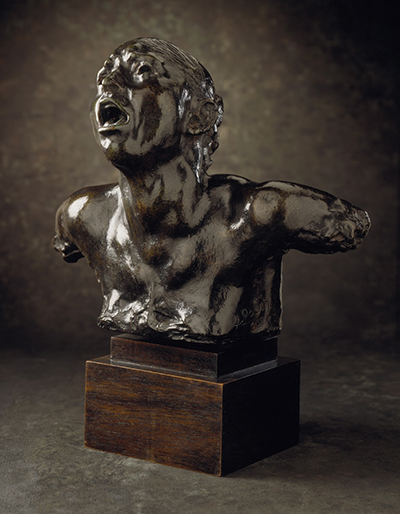Auguste Rodin loved to connect with his sculptures, essentially feeling their emotions as if they were living people. In some cases he would even develop romantic feelings for them. In this case he focuses on the drama of anguish, delivering a memorable piece which now resides at the Los Angeles County Museum of Art.
Here we find a middle aged man staring upwards in a state of desperation. Rodin produces a bust for this piece which increased the focus on the cry of this figure. As far as we can tell, the model itself was completed by the artist in 1886, but the bronze sculpture was cast many years later in 1964. There are many question marks around this lesser-known piece, with the main one being around who created the final sculpture, as Rodin passed away in 1917. It was the Musee Rodin who made use of the original model and it would later become a gift of the B. Gerald Cantor Art Foundation to the Los Angeles art institution, where it resides today. One of the advantages and disadvantages of sculpture is the ability to continue to make more copies and versions over time, though this has muddied the water of attribution in many cases.
The Museum which continues to promote his life and career have made huge efforts in recent years to document all that he left behind within his mansion. It remains the best place to understand more about his achievements and it is rare to have such a large proportion of an artist's work to be stored under one roof. They discovered around 7,000 photographic prints collected by the artist over the course of his lifetime and have used these to present a visual display of his lifetime. There were also many models and sculptures found around his studio that may not have been known about previously. Exhibitions of the artist's work are frequent, with curators wanting to feature prominent sculptors from the 19th century and this man generally topping the bill. Selling tickets for lesser known sculptors can be a hard challenge, but thankfully there is much from Rodin that can be loaned for the purpose of a short exhbition.
The Great Wave off Kanagawa by Hokusai remains the most famous item in their collection, whilst South Wind, Clear Dawn also continues their impressive Japanese offering. They also own a number of other Rodin sculptures that were actually cast a good period after his passing, such as Monumental Head of Jean d'Aire and The Shade. There is also Grande Arabesque by Edgar Degas. In all, the diversity of this collection is extraordinary, and one can imagine tourists enjoying themselves here because of the great selection of different items from all manner of different civilisations that should be able to keep anyone and everyone engrossed for at least a few hours at a time.




